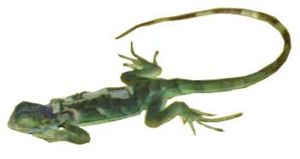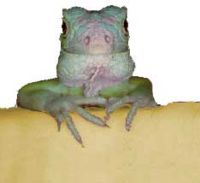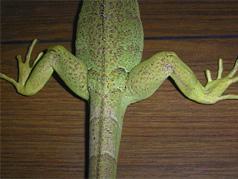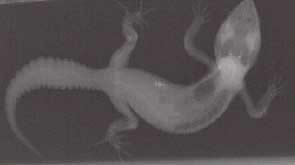Difference between revisions of "Lizard Metabolic Bone Disease"
| (27 intermediate revisions by 4 users not shown) | |||
| Line 1: | Line 1: | ||
| − | {{ | + | {{review}} |
| − | [[Image:Mbd_iguana.jpg|300px|thumb|right|'''Iguanas with MBD have difficulty in supporting their own bodyweight and therefore lay flat''' (© RVC and | + | [[Image:Mbd_iguana.jpg|300px|thumb|right|'''Iguanas with MBD have difficulty in supporting their own bodyweight and therefore lay flat''' (Copyright © RVC)]] |
| + | [[Image:Iguana_mbd_swollenjaw.jpg|200px|thumb|right|'''Green iguana with MBD and swollen jaw''' (Copyright © RVC)]] | ||
| + | [[Image:Lizard_thigh_mbd.jpg|300px|thumb|right|'''Enlargement of the thigh on the right due to fibrous osteodystrophy of the right femur''' (Copyright © RVC)]] | ||
| + | [[Image:Leopardgecko_mbd_xray.jpg|300px|thumb|right|'''Radiograph of Leopard gecko showing signs of MBD. Decreased opacity to the pelvis and caudal vertebrae. No clear contrast between bone and soft tissue is a classic sign of MBD.''' (Copyright © RVC)]] | ||
| − | + | ==Introduction== | |
| − | + | Metabolic bone disease (MBD) is a complex disease that is associated with derangement of the metabolism of [[Calcium - Reptiles|calcium]], [[Phosphorus - Reptiles|phosphorus]] and vitamin D3, poor husbandry and other diseases. | |
| − | Metabolic bone disease (MBD) is a complex disease that is associated with derangement of the metabolism of calcium, phosphorus and vitamin D3, poor husbandry and other diseases. | ||
| − | MBD is the most common disease in captive lizards, especially green iguanas; it is usually a result of poor husbandry. For example, deficiency in Vitamin D3 and/or UVB in combination with calcium deficiency leads to metabolic bone disease. Associated terms include fibrous osteodystrophy, nutritional secondary hyperparathyroidism, osteoporosis, osteomalacia and rickets. | + | MBD is the most common disease in captive lizards, especially [[Green Iguana|green iguanas]]; it is usually a result of poor husbandry. For example, deficiency in Vitamin D3 and/or UVB in combination with calcium deficiency leads to metabolic bone disease. Associated terms include fibrous osteodystrophy, nutritional secondary hyperparathyroidism, osteoporosis, osteomalacia and rickets. |
| − | Extreme care should be taken when examining animals with MBD as their bones are weakened and easily fractured. | + | Extreme care should be taken when examining animals with MBD as their bones are weakened and easily [[Lizard Long Bone Fractures|fractured]]. |
| − | |||
| − | + | ==Clinical signs== | |
| − | + | These include: | |
*Lethargy and reluctance to move | *Lethargy and reluctance to move | ||
| Line 22: | Line 23: | ||
*Weight loss to poor weight gain | *Weight loss to poor weight gain | ||
*Softening, swelling and deformities of bones e.g. soft mandibles | *Softening, swelling and deformities of bones e.g. soft mandibles | ||
| − | *Pathological fractures | + | *[[Lizard Long Bone Fractures|Pathological fractures]] |
*Muscle fasciculations and seizures | *Muscle fasciculations and seizures | ||
| − | When juveniles have been affected during growth, they may have poorly mineralized and pliable mandibles which is a sign of prolonged MBD. This results in distorted jaw bones and a characteristic facial 'smile'. In chameleon species, MBD causes difficulty protruding or retracting the tongue. | + | When juveniles have been affected during growth, they may have poorly mineralized and pliable mandibles which is a sign of prolonged MBD. This results in distorted jaw bones and a characteristic facial 'smile'. In [[Chameleon|chameleon]] species, MBD causes difficulty protruding or retracting the tongue. |
| − | Tremors, muscular fasciculations, paresis and seizures usually develop in more severe cases of MBD with developed hypocalcaemia. However in most cases, calcium and phosphate levels usually appear normal. | + | Tremors, muscular fasciculations, paresis and seizures usually develop in more severe cases of MBD with developed hypocalcaemia. However in most cases, [[Calcium - Reptiles|calcium]] and phosphate levels usually appear normal. |
| − | In some cases, hindlimbs may appear very muscular as a result of thickening of the bone cortex caused by marked fibrous osteodystrophy in the long bones. Palpation or radiography suffice to differenciate from healthy tissue. In addition, the costochondral junctions may appear enlarged and distorted. | + | In some cases, hindlimbs may appear very muscular as a result of thickening of the bone cortex caused by marked fibrous osteodystrophy in the long bones. Palpation or [[Lizard and Snake Imaging|radiography]] suffice to differenciate from healthy tissue. In addition, the costochondral junctions may appear enlarged and distorted. |
| − | |||
| − | + | ==Diagnosis== | |
Diagnosis is dependent on: | Diagnosis is dependent on: | ||
| − | *History - dietary and environmental evaluation; directed towards identifying possible causes of calcium and | + | *History - dietary and environmental evaluation; directed towards identifying possible causes of calcium and vitamin D3 deficiency. |
| − | *Physical examination | + | *[[Lizard Physical Examination|Physical examination]] |
*Radiography - hypomineralisation of skeleton, pathological fractures, fibrous osteodystrophy. Radiographs are very effective in confirming the diagnosis; indeed, radiolucent transverse processes in the caudal vertebrae are pathognomonic of MBD in lizards. | *Radiography - hypomineralisation of skeleton, pathological fractures, fibrous osteodystrophy. Radiographs are very effective in confirming the diagnosis; indeed, radiolucent transverse processes in the caudal vertebrae are pathognomonic of MBD in lizards. | ||
| − | *Biochemistry - calcium is generally within normal limits but may be low, especially in neurological cases; the calcifediol assay can be done on plasma to determine the status. | + | *Biochemistry - [[Calcium - Reptiles|calcium]] is generally within normal limits but may be low, especially in neurological cases; the calcifediol assay can be done on plasma to determine the status. |
| − | + | ==Treatment== | |
| − | Initial focus should be on improving calcium intake as well as access to appropraite UVB light. Parenteral injections of calcium or oral solutions can be used on animals with clinical hypocalcaemia (when renal failure has been ruled out). | + | Initial focus should be on improving [[Calcium - Reptiles|calcium]] intake as well as access to appropraite UVB light. Parenteral injections of calcium or oral solutions can be used on animals with clinical hypocalcaemia (when renal failure has been ruled out). |
* Administer oral calcium for non-neurological cases - calcium glubionate (NeoCalglucon, Sandoz) at 1 ml/kg bw q12-24h for 1-3 months. | * Administer oral calcium for non-neurological cases - calcium glubionate (NeoCalglucon, Sandoz) at 1 ml/kg bw q12-24h for 1-3 months. | ||
| − | * Administer parenteral calcium for neurological cases, preferably IV or ICo by slow infusion (100-500 mg/kg q6h) and concurrent diuresis with serial plasma calcium and phosphorus measurements. | + | * Administer parenteral [[Calcium - Reptiles|calcium]] for neurological cases, preferably IV or ICo by slow infusion (100-500 mg/kg q6h) and concurrent diuresis with serial plasma calcium and phosphorus measurements. |
* Calcitonin has previously been suggested as a treatment - 50 iu/kg IM weekly for 1-4 weeks, but its clinical effects have not been established (do not give to hypocalcaemic patients). | * Calcitonin has previously been suggested as a treatment - 50 iu/kg IM weekly for 1-4 weeks, but its clinical effects have not been established (do not give to hypocalcaemic patients). | ||
* Vitamine D deficiency can be addressed by UVB exposure as long as the kidney and liver functions are normal. | * Vitamine D deficiency can be addressed by UVB exposure as long as the kidney and liver functions are normal. | ||
* Treatment should be given every 6-12 hours until noticeable clinical signs have ceased (e.g. seizures, fasciculations). | * Treatment should be given every 6-12 hours until noticeable clinical signs have ceased (e.g. seizures, fasciculations). | ||
| − | Carry out supportive care. | + | Carry out [[Lizard Supportive Care|supportive care]]. |
| − | Attempt only conservative repair of fractures by stabilizing bones with external coaptation . | + | Attempt only conservative repair of [[Lizard Long Bone Fractures|fractures]] by stabilizing bones with external coaptation . |
| − | + | ==Prevention== | |
MBD is prevented by providing correct housing and diet. However, caging and dietary requirements vary depending on the species of lizard. | MBD is prevented by providing correct housing and diet. However, caging and dietary requirements vary depending on the species of lizard. | ||
| + | |||
| + | ==Literature Search== | ||
| + | [[File:CABI logo.jpg|left|90px]] | ||
| + | |||
| + | |||
| + | Use these links to find recent scientific publications via CAB Abstracts (log in required unless accessing from a subscribing organisation). | ||
| + | <br><br><br> | ||
| + | [http://www.cabdirect.org/search.html?q=(title:(lizard)+OR+ab:(lizard)+OR+od:(lizards))+AND+(title:(Metabolic+Bone+Disease)+OR+ab:(Metabolic+Bone+Disease)+OR+subject:(Metabolic+Bone+Disease)+OR+de:(Metabolic+Bone+Disease))&fq=sc:%22ve%22 Lizard Metabolic Bone Disease publications] | ||
==References== | ==References== | ||
* Girling, S.J. and Raiti, P. (2004). BSAVA Manual of Reptiles. British Small Animal Veterinary Association, 2nd Edition. pp. 350. ISBN 978-0905214757 | * Girling, S.J. and Raiti, P. (2004). BSAVA Manual of Reptiles. British Small Animal Veterinary Association, 2nd Edition. pp. 350. ISBN 978-0905214757 | ||
| − | [[Category: | + | [[Category:Lizard_Diseases]] |
Latest revision as of 20:37, 5 November 2010
| This article has been peer reviewed but is awaiting expert review. If you would like to help with this, please see more information about expert reviewing. |
Introduction
Metabolic bone disease (MBD) is a complex disease that is associated with derangement of the metabolism of calcium, phosphorus and vitamin D3, poor husbandry and other diseases.
MBD is the most common disease in captive lizards, especially green iguanas; it is usually a result of poor husbandry. For example, deficiency in Vitamin D3 and/or UVB in combination with calcium deficiency leads to metabolic bone disease. Associated terms include fibrous osteodystrophy, nutritional secondary hyperparathyroidism, osteoporosis, osteomalacia and rickets.
Extreme care should be taken when examining animals with MBD as their bones are weakened and easily fractured.
Clinical signs
These include:
- Lethargy and reluctance to move
- Difficulty in lifting body off ground
- Ataxia, paresis and paralysis of hindlimbs
- Poor appetite to anorexia
- Weight loss to poor weight gain
- Softening, swelling and deformities of bones e.g. soft mandibles
- Pathological fractures
- Muscle fasciculations and seizures
When juveniles have been affected during growth, they may have poorly mineralized and pliable mandibles which is a sign of prolonged MBD. This results in distorted jaw bones and a characteristic facial 'smile'. In chameleon species, MBD causes difficulty protruding or retracting the tongue.
Tremors, muscular fasciculations, paresis and seizures usually develop in more severe cases of MBD with developed hypocalcaemia. However in most cases, calcium and phosphate levels usually appear normal.
In some cases, hindlimbs may appear very muscular as a result of thickening of the bone cortex caused by marked fibrous osteodystrophy in the long bones. Palpation or radiography suffice to differenciate from healthy tissue. In addition, the costochondral junctions may appear enlarged and distorted.
Diagnosis
Diagnosis is dependent on:
- History - dietary and environmental evaluation; directed towards identifying possible causes of calcium and vitamin D3 deficiency.
- Physical examination
- Radiography - hypomineralisation of skeleton, pathological fractures, fibrous osteodystrophy. Radiographs are very effective in confirming the diagnosis; indeed, radiolucent transverse processes in the caudal vertebrae are pathognomonic of MBD in lizards.
- Biochemistry - calcium is generally within normal limits but may be low, especially in neurological cases; the calcifediol assay can be done on plasma to determine the status.
Treatment
Initial focus should be on improving calcium intake as well as access to appropraite UVB light. Parenteral injections of calcium or oral solutions can be used on animals with clinical hypocalcaemia (when renal failure has been ruled out).
- Administer oral calcium for non-neurological cases - calcium glubionate (NeoCalglucon, Sandoz) at 1 ml/kg bw q12-24h for 1-3 months.
- Administer parenteral calcium for neurological cases, preferably IV or ICo by slow infusion (100-500 mg/kg q6h) and concurrent diuresis with serial plasma calcium and phosphorus measurements.
- Calcitonin has previously been suggested as a treatment - 50 iu/kg IM weekly for 1-4 weeks, but its clinical effects have not been established (do not give to hypocalcaemic patients).
- Vitamine D deficiency can be addressed by UVB exposure as long as the kidney and liver functions are normal.
- Treatment should be given every 6-12 hours until noticeable clinical signs have ceased (e.g. seizures, fasciculations).
Carry out supportive care.
Attempt only conservative repair of fractures by stabilizing bones with external coaptation .
Prevention
MBD is prevented by providing correct housing and diet. However, caging and dietary requirements vary depending on the species of lizard.
Literature Search
Use these links to find recent scientific publications via CAB Abstracts (log in required unless accessing from a subscribing organisation).
Lizard Metabolic Bone Disease publications
References
- Girling, S.J. and Raiti, P. (2004). BSAVA Manual of Reptiles. British Small Animal Veterinary Association, 2nd Edition. pp. 350. ISBN 978-0905214757




